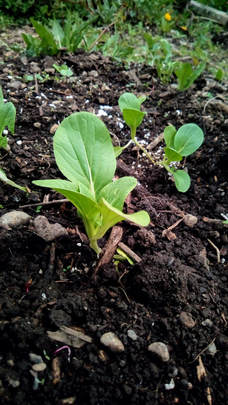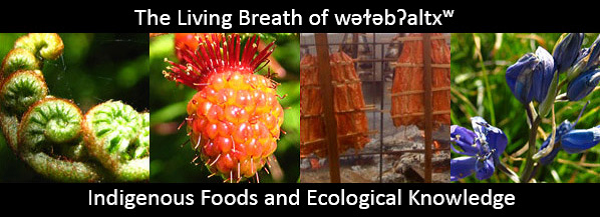 Pak choi establishing itself in its new garden bed
Pak choi establishing itself in its new garden bed Systems are full of cycles, feedback loops, and interconnections with other systems. An ecosystem is a great example of a whole made of many parts, with flows into the system (such as sunlight, water, and wind) and flows out (such as food, oxygen and clean water). A healthy system has buffers to keep its feedback loops stable, but also the ability to alter its cycles to adapt to input changes. An ecosystem is a living thing composed of many other living things, who exist in a complementary pattern. The waste of one being might be the food of another. One organism’s ability to make nutrients available to another (such as by fixing nitrogen from the atmosphere into the soil) is encouraged by the other organism making different nutrients available in return (perhaps by leaking them into the soil through its root system). Or one species may make shade, while another provides vertical structure for a vine species to climb.
The more organisms there are than can provide similar services, the more resilient the ecosystem tends to be. For example, if one producer gets stressed by an unusual weather pattern such as an unseasonal frost, if a less vulnerable producer can perform that service for the ecosystem until the first producer recovers. Redundancy is a benefit - as long as it is not complete competition, in which case the more successful species is likely to replace the one that is less well-adapted.
Complexity is a benefit to many living systems, but humans are challenged by it; we often feel inclined to simplify a system to make it more predictable and under our control. Unfortunately, a policy that makes it easy to use massive machinery to predictably harvest profitable monocrops also means that if an unusual weather event takes place, the whole crop can fail at once. Many famines have been caused by excessive simplification of agricultural systems, which, when they collapsed, had nothing to supplement them. That’s why it’s important to think about the long-term impact of choices that may have great short-term benefits. Scaling up an endeavor into a highly profitable enterprise is tempting, but it’s important not to do so without thinking about the consequences of also scaling up the emissions of a certain kind of waste beyond the ability of the environment to dilute or transform it.
To me, Permaculture is about cultivating a complex, balanced system that has the ability to self-organize (because the many species can adjust their relationships to one another as needed for the benefit of all) and self-heal (because when one part of the system is damaged, another is ready to fill in for that function). Diversity is important, as is the co-evolution of species that work as partners. Systems with powerful emergent properties, such as making a fertile place increasingly more fertile through their activities, take time to develop. The willingness to not force the system, but let it find its own balance while patiently observing what factors adjust themselves and why is a way to help join in the dance. In that way, humans become a useful part of their ecosystem – greater than themselves, greater than the human society, a functioning part of a whole that includes every living thing in and on the land and water where we make our home.






 RSS Feed
RSS Feed